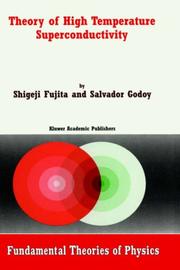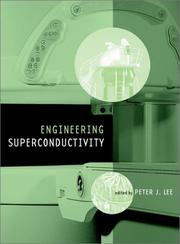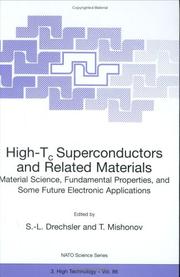| Listing 1 - 6 of 6 |
Sort by
|

ISBN: 1402001495 Year: 2001 Publisher: Dordrecht : Kluwer academic,
Abstract | Keywords | Export | Availability | Bookmark
 Loading...
Loading...Choose an application
- Reference Manager
- EndNote
- RefWorks (Direct export to RefWorks)
The book describes all basic experimental facts about high temperature superconductivity of materials, with a critical temperature of 30 Kelvin and higher, and explains them microscopically starting with a Hamiltonian followed by step-by-step statistical mechanical calculations. All important theoretical formulas are derived without omitting steps and all basic questions are answered in a manner which is easy to understand. The book is therefore suitable as a textbook for a second-year graduate physics course. Many fresh, and some challenging, ideas are presented and researches in the field are invited to examine the text.
Book
Year: 2001 Publisher: Cleveland, Ohio : National Aeronautics and Space Administration, Glenn Research Center,
Abstract | Keywords | Export | Availability | Bookmark
 Loading...
Loading...Choose an application
- Reference Manager
- EndNote
- RefWorks (Direct export to RefWorks)
Lubrication systems. --- Ball bearings. --- Oils. --- High temperature.
Book
Year: 2001 Publisher: Cleveland, Ohio : National Aeronautics and Space Administration, Glenn Research Center,
Abstract | Keywords | Export | Availability | Bookmark
 Loading...
Loading...Choose an application
- Reference Manager
- EndNote
- RefWorks (Direct export to RefWorks)
Grain boundaries. --- High temperature. --- Failure modes. --- Metal fatigue. --- Creep properties. --- Deformation. --- Cracking (fracturing)

ISBN: 0471411167 9780471411161 9780470547175 0470547170 Year: 2001 Publisher: [Hoboken, New Jersey] : [Piscataqay, New Jersey] : Wiley-Interscience, IEEE Xplore,
Abstract | Keywords | Export | Availability | Bookmark
 Loading...
Loading...Choose an application
- Reference Manager
- EndNote
- RefWorks (Direct export to RefWorks)
Comprehensive coverage of superconductivity from the Wiley Encyclopedia of Electrical and Electronics Engineering Engineering Superconductivity features fifty articles selected from the Wiley Encyclopedia of Electrical and Electronics Engineering, the one truly indispensable reference for electrical engineers. Superconductor technology has made highly advanced experiments possible in chemistry, biochemistry, particle physics, and health sciences, and introduced new applications currently in use in fields from medicine to cellular communications. Taken together, these articles-written by acknowledged experts in the field-provide the most complete and in-depth accounting of superconductivity in existence. The book brings together a wealth of information that would not be available to those who do not have access to the full 24-volume encyclopedia. This thorough survey looks at the application of superconductors from an engineer's practical perspective rather than a theoretical approach. Engineering Superconductivity provides full coverage of the fundamentals of superconducting behavior and explains the properties and fabrication methods of commercially produced superconductors. Up-to-date material on superconductor applications as well as competing technologies is included. The fifty articles presented here are divided into three sections: . Superconductivity and magnetism. Superconductors. Applications and related technology Engineering Superconductivity is a complete and up-to-date reference for engineers, physicists, chemists, materials scientists, and anyone working with superconductors.
537.6 --- Magnetism --- 537.6 Magnetism --- High temperature superconductors --- Superconductors --- Electrical & Computer Engineering --- Engineering & Applied Sciences --- Electrical Engineering --- Industrial applications --- Superconducting materials --- Superconductive devices --- Cryoelectronics --- Electronics --- Solid state electronics --- Materials at low temperatures --- Materials --- Industrial applications.

ISBN: 079236872X 0792368738 9401007586 Year: 2001 Volume: 86 Publisher: Dordrecht : Kluwer,
Abstract | Keywords | Export | Availability | Bookmark
 Loading...
Loading...Choose an application
- Reference Manager
- EndNote
- RefWorks (Direct export to RefWorks)
A broad introduction to high Tc superconductors, their parent compounds and related novel materials, covering both fundamental questions of modern solid state physics (such as correlation effects, fluctuations, unconventional symmetry of superconducting order parameter) and applied problems related to short coherence length, grain boundaries and thin films. The information that can be derived from electron spectroscopy and optical measurements is illustrated and explained in detail. Descriptions widely employ the clear, relatively simple, phenomenological Ginzburg-Landau model of complex phenomena, such as vortex physics, vortex charge determination, plasmons in superconductors, Cooper pair mass, and wetting of surfaces. The first comprehensive reviews of several novel classes of materials are presented, including borocarbides and chain cuprates.
538.945 <063> --- High-temperature superconductors --- Materials at low temperatures --- Superconductors --- Superconductivity--Congressen --- Physics --- Physical Sciences & Mathematics --- Atomic Physics --- Electricity & Magnetism --- 538.945 <063> Superconductivity--Congressen --- High temperature superconductors --- Congresses --- Low temperature physics. --- Low temperatures. --- Optics. --- Electrodynamics. --- Condensed matter. --- Physical chemistry. --- Magnetism. --- Magnetic materials. --- Materials science. --- Low Temperature Physics. --- Classical Electrodynamics. --- Condensed Matter Physics. --- Physical Chemistry. --- Magnetism, Magnetic Materials. --- Characterization and Evaluation of Materials. --- Material science --- Physical sciences --- Materials --- Mathematical physics --- Electricity --- Magnetics --- Chemistry, Theoretical --- Physical chemistry --- Theoretical chemistry --- Chemistry --- Condensed materials --- Condensed media --- Condensed phase --- Materials, Condensed --- Media, Condensed --- Phase, Condensed --- Liquids --- Matter --- Solids --- Dynamics --- Light --- Cryogenics --- Low temperature physics --- Temperatures, Low --- Temperature --- Cold --- Borides --- Carbides --- Copper compounds --- Josephson effect --- Plasmon --- Ruthenium compounds
Book
ISBN: 0306482169 Year: 2001 Publisher: Dordrecht ; Boston : Kluwer Academic Publishers,
Abstract | Keywords | Export | Availability | Bookmark
 Loading...
Loading...Choose an application
- Reference Manager
- EndNote
- RefWorks (Direct export to RefWorks)
Flux quantization experiments indicate that the carriers, Cooper pairs (pairons), in the supercurrent have charge magnitude 2e, and that they move independently. Josephson interference in a Superconducting Quantum Int- ference Device (SQUID) shows that the centers of masses (CM) of pairons move as bosons with a linear dispersion relation. Based on this evidence we develop a theory of superconductivity in conventional and mate- als from a unified point of view. Following Bardeen, Cooper and Schrieffer (BCS) we regard the phonon exchange attraction as the cause of superc- ductivity. For cuprate superconductors, however, we take account of both optical- and acoustic-phonon exchange. BCS started with a Hamiltonian containing “electron” and “hole” kinetic energies and a pairing interaction with the phonon variables eliminated. These “electrons” and “holes” were introduced formally in terms of a free-electron model, which we consider unsatisfactory. We define “electrons” and “holes” in terms of the cur- tures of the Fermi surface. “Electrons” (1) and “holes” (2) are different and so they are assigned with different effective masses: Blatt, Schafroth and Butler proposed to explain superconductivity in terms of a Bose-Einstein Condensation (BEC) of electron pairs, each having mass M and a size. The system of free massive bosons, having a quadratic dispersion relation: and moving in three dimensions (3D) undergoes a BEC transition at where is the pair density.
Physics. --- Physical chemistry. --- Condensed matter. --- Statistical physics. --- Dynamical systems. --- Condensed Matter Physics. --- Physical Chemistry. --- Statistical Physics, Dynamical Systems and Complexity. --- Dynamical systems --- Kinetics --- Mathematics --- Mechanics, Analytic --- Force and energy --- Mechanics --- Physics --- Statics --- Mathematical statistics --- Condensed materials --- Condensed media --- Condensed phase --- Materials, Condensed --- Media, Condensed --- Phase, Condensed --- Liquids --- Matter --- Solids --- Chemistry, Theoretical --- Physical chemistry --- Theoretical chemistry --- Chemistry --- Natural philosophy --- Philosophy, Natural --- Physical sciences --- Dynamics --- Statistical methods --- Complex Systems. --- Statistical Physics and Dynamical Systems. --- High temperature superconductivity. --- High critical temperature superconductivity --- High Tc superconductivity --- Superconductivity
| Listing 1 - 6 of 6 |
Sort by
|

 Search
Search Feedback
Feedback About UniCat
About UniCat  Help
Help News
News